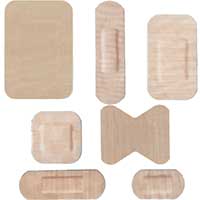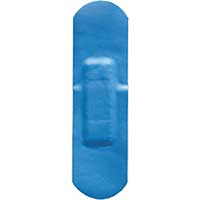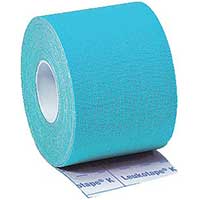 Who is Leukoplast?
Who is Leukoplast?
If you feel like you recognise some of the below plasters, you probably do – they used to be known as Coverplast. They are the same professional quality, just a new name. With over 100 years of experience providing premium-quality wound care solutions, Leukoplast (previously Coverplast) is the go-to brand for premium plasters, dressings and tapes. Pioneering from the very beginning, Coverplast invented the world’s first self-adhesive plaster tape in 1901, using zinc oxide and natural rubber. They have since continued to innovate and lead in their field and now provide a full range of wound care solutions for use both by medical professionals and for self-treatment at home.
How to use Leukoplast
- Make sure you have stopped the bleeding before applying the plaster. You can do this by applying pressure to the area, using a clean, dry and absorbent material.
- Wash your hands thoroughly.
- Clean the wound and dry the area gently with a clean towel. Do not use antiseptic to clean the wound, as this could delay healing. Instead, clean it under drinking-quality tap water.
-
Choose the right size plaster, making sure that the wound pad is slightly larger than the wound and that the shape is correct for the area of the body:
- Remove the plaster from the sterile dressing and peel back the protective strips.
- Holding the plaster by the protective strips, place the wound pad so that it fits over the wound and then peel the protective strips off entirely. Press down the edges of the plaster to secure it.
Types of Leukoplast Plaster:
Leukoplast provides plasters for a range of environments and in a range of sizes to fit various areas of the body. Despite the plasters having highly adhesive qualities, they are breathable with absorbent and low-adherent wound pads, preventing maceration.

With their highly adhesive qualities and flexibility, these plasters are able to remain in place far longer than the average household plaster. Previously known as Coverplast Classic, they are ideal for minor wounds, such as lacerations, cuts and abrasions, particularly for situations where a high level of movement is still required.
Leukoplast barrier plasters are waterproof and protect against bacterial contamination.
The waterproof dressing on these plasters helps to prevent secondary wound infection by protecting against bacterial contamination. These plasters were previously known by the name Coverplast Barrier. Conformable and comfortable with strong adhesion, the plasters will stay in place even in wet environments.
 Leukoplast detectable plasters can be detected by X-ray and metal detectors
Leukoplast detectable plasters can be detected by X-ray and metal detectors
Waterproof and conformable, these plasters are protective and comfortable in food production and catering environments. Previously known as Coverplast Detectable, they are highly detectable: visually, due to the blue colour not found in natural food; by x-ray, due to the tungsten filaments; and by metal detector (non-ferrous), due to a layer of aluminium.
How to use Leukotape
Leukotape can be used to support and stabilise sports injuries, as well as stabilising and protecting weak muscles, joints or ligaments, without restricting movement or circulation.
For detailed guidance on how to apply Leukotape, watch the instructional videos on Leukotape’s YouTube channel.
Types of Leukotape:
Leukotape K: Elastic Kinesiology Tape
Leukotape K is used both by hospitals and sporting communities to treat swelling and discomfort, relieve pain and improve strength and coordination. The tapes work with the skin’s natural elasticity, are durable (last up to one week), breathable and low-allergy (latex-free). They allow complete freedom of movement while promoting the body’s healing process.
What is zinc oxide tape?
Zinc oxide tape is a favourite among athletes and physiotherapists. The use of zinc oxide in the adhesive mix creates the tape’s reliably strong adhesive qualities, created by the use of zinc oxide. In addition to strong adhesion, zinc oxide has also been shown to have antibacterial properties, making it a doubly effective compound to be used in strapping tape.
Leukotape Classic: Rigid Zinc Oxide Strapping Tape
Leukotape Classic provides particularly strong and long-term adhesion, due to the zinc oxide, giving extra strength to its support and stabilisation of joint structures. It is non-elastic, tearable and water-resistant strapping tape and is made from 100% cotton.
Leukotape P: High Adhesive Zinc Oxide Rigid Strapping Tape
Leukotape P is the perfect choice for patellofemoral taping where strong adhesion is required, due to its very strong zinc oxide adhesive and high strength tape.
Strappal: Hypoallergenic Zinc Oxide Rigid Strapping Tape
With its hypoallergenic adhesive, Strappal provides strong support and efficient stabilisation of joint structures with a minimised risk of reaction for the patient. Joints can be radiologically examined without removal of the tape, allowing it to support the patient throughout the medical process.
Is zinc oxide tape used for blisters?
Due to the breathable and antibacterial qualities of zinc oxide tape, it is also recommended by many to prevent blisters. Using tape on areas of the foot that are prone to blisters protects the skin from rubbing against socks or shoes, reducing the likelihood of blisters. The high adhesion of zinc oxide tape makes it a favourite amongst hikers and endurance athletes who would need the tape to remain sticky for long periods.
Other popular products by Essity:
Make sure you understand exactly what your workplace needs and that you have the necessary first aid kits and equipment to provide effective first aid wherever you are.
Read our blog for more information on first aid or contact us for further advice and information on our products.


























